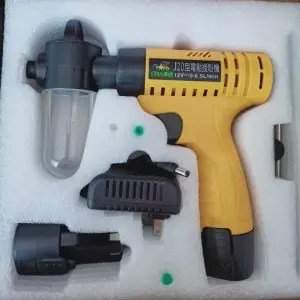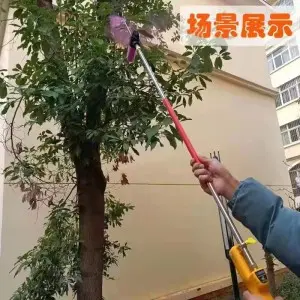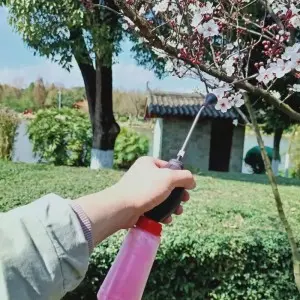សីហា . 27, 2025 03:40 Back to list
Artificial Pollination: Boost Crop Yields Efficiently
The Imperative of Precision: Revolutionizing Crop Yield with Advanced Pollination Technologies
In modern agriculture, the challenges of declining natural pollinator populations and the demand for higher, more consistent crop yields necessitate innovative solutions. One such critical innovation is artificial pollination. This technological advancement offers a precise and controlled method to ensure successful fertilization, directly impacting agricultural productivity and food security. As a specialized field within agritech, it encompasses sophisticated equipment and methodologies designed to optimize the transfer of viable plant pollen, leading to superior fruit set and quality.
The global agricultural landscape is rapidly evolving, driven by population growth, climate change, and resource constraints. Traditional pollination methods, often reliant on insect pollinators like bees, face significant threats, including habitat loss, pesticide exposure, and disease. These factors underscore the urgent need for reliable, efficient, and scalable alternatives. Advanced artificial pollination systems not only mitigate these risks but also introduce a level of control and predictability previously unattainable, allowing growers to manage outcomes with greater precision.
Industry Trends and Market Dynamics in Artificial Pollination
The market for artificial pollination technologies is experiencing robust growth, propelled by several macro-environmental factors. A key driver is the alarming decline in natural pollinator populations worldwide, with studies reporting significant reductions in bee colonies. This ecological crisis directly threatens the productivity of over 75% of the world's leading food crops that rely on animal pollination. Consequently, growers are increasingly turning to engineered solutions to secure their yields.
Another significant trend is the rise of precision agriculture and controlled environment farming. These advanced farming systems demand predictable and optimized inputs, making manual or mechanical artificial pollination an ideal fit. Technologies such as automated drones, robotic systems, and handheld electric pollinators are gaining traction, allowing for targeted pollen application, reduced labor costs, and enhanced efficiency. Furthermore, the increasing specialization of crops and the need for specific pollen types for hybridization and varietal improvement are fueling innovation in pollen collection, storage, and application techniques.

Image 1: Demonstrating precise application during artificial pollination.
Data from recent market research indicates the global artificial pollination market is projected to grow at a Compound Annual Growth Rate (CAGR) of over 10% from 2023 to 2030, reaching billions of dollars. This growth is primarily observed in high-value fruit and nut crops, as well as seed production where yield consistency and genetic purity are paramount. North America and Europe are leading the adoption due to high labor costs and increasing awareness of pollinator decline, while Asia-Pacific is emerging as a significant market owing to rapid agricultural modernization and large-scale horticultural operations.
Manufacturing and Operational Process Flow of Advanced Pollination Equipment
The effectiveness of artificial pollination hinges on the quality and reliability of the equipment used. The manufacturing process of advanced electric pollinators, such as the LITHIUM ELECTRIC POLLINATOR FOR ORCHARD, involves meticulous engineering and adherence to stringent quality controls to ensure optimal performance and longevity.
Product Materials and Component Sourcing
High-performance electric pollinators typically utilize a combination of durable and lightweight materials. The housing often consists of high-grade engineering plastics (e.g., ABS, PC-GF blends) for impact resistance and ergonomic design, frequently produced via injection molding. Internal components, including motor shafts, gears, and fasteners, are usually precision-machined from stainless steel (e.g., SUS304) or specialized aluminum alloys (e.g., 6061-T6) for corrosion resistance and structural integrity. Critical elements like the lithium-ion battery packs are sourced from certified manufacturers, ensuring compliance with international safety standards such as UL2054 and IEC62133. Brush materials for pollen collection and application are carefully selected for their ability to effectively transfer delicate plant pollen without causing damage, often synthetic microfibers or natural bristles.
Manufacturing Processes
- Injection Molding: Used for creating lightweight, durable casings and ergonomic handles from polymer composites. This process ensures high dimensional accuracy and repeatability.
- CNC Machining: Precision components like motor housing, drive shafts, and specialized nozzles are often produced via CNC milling and turning from metal billets, ensuring tight tolerances for smooth operation and durability.
- Electrical Assembly: Integration of the lithium-ion battery, motor, control circuit board, and wiring. This step involves meticulous soldering, wiring harnesses, and quality checks for electrical conductivity and safety.
- Final Assembly: All sub-assemblies are integrated, tested for mechanical fit, and subjected to functional tests to verify motor speed, battery life, and pollen dispersion patterns.
Testing Standards and Quality Assurance
To guarantee performance and reliability, electric pollinators undergo rigorous testing. Key standards include:
- ISO 9001:2015: Certification for quality management systems, ensuring consistent product quality from design to delivery.
- ANSI/UL Standards: For electrical safety, particularly for battery packs and charging systems, to prevent hazards like overheating or short circuits.
- CE Mark: Compliance with European health, safety, and environmental protection standards.
- IP Rating (e.g., IPX4): Ensuring resistance to water splashes and dust ingress, crucial for agricultural environments.
- Environmental Testing: Devices are tested for performance under varying temperatures, humidity, and vibration, simulating real-world agricultural conditions.
Service Life and Target Industries
A well-engineered electric pollinator is designed for a service life of 5-10 years, depending on usage intensity and maintenance. This robust construction makes them indispensable across various agricultural sectors:
- Horticulture & Orchards: Primary target for fruit trees (apples, pears, cherries, kiwis) and nut trees.
- Greenhouse & Protected Cultivation: Vegetables (tomatoes, peppers, cucumbers) and flowers where natural pollinators are absent or insufficient.
- Seed Production: Ensuring genetic purity and high germination rates for specific seed varieties.
- Research & Development: For controlled experiments on crop breeding and genetic studies involving specific pollen types.
Advantages in Typical Application Scenarios
In diverse application scenarios, the advantages of sophisticated artificial pollination equipment are profound:
- Enhanced Energy Efficiency: Lithium-electric models offer significantly lower operational costs compared to manual labor or fuel-powered alternatives. A single charge can support hours of continuous operation, crucial during peak pollination windows.
- Superior Corrosion Resistance: Components crafted from stainless steel and robust engineering plastics ensure long-term performance even when exposed to agricultural chemicals, moisture, and pollen dust, which can be corrosive.
- Precision and Uniformity: The controlled application mechanism ensures even distribution of plant pollen across floral surfaces, leading to a more uniform fruit set and consistent quality, reducing culls and increasing marketable yield.
- Reduced Labor Dependence: Automating or semi-automating the pollination process drastically reduces the reliance on skilled manual labor, addressing a common challenge in agricultural workforces.
Technical Specifications: LITHIUM ELECTRIC POLLINATOR FOR ORCHARD
The LITHIUM ELECTRIC POLLINATOR FOR ORCHARD is engineered for maximum efficiency and ergonomic operation, providing a superior solution for intensive horticultural applications. Below are detailed technical specifications that highlight its capabilities and design principles.
This sophisticated design ensures that the pollinator provides consistent and efficient artificial pollination, contributing significantly to yield optimization. The interchangeable heads allow for versatility, accommodating different floral structures and densities, crucial for various plant pollen characteristics.
Application Scenarios and Strategic Implementation
The versatility of advanced artificial pollination equipment makes it suitable for a wide array of agricultural settings, addressing specific challenges in each. Strategic implementation involves understanding the crop, environmental conditions, and available labor.
Orchard Cultivation
For deciduous and evergreen fruit orchards (e.g., apples, pears, cherries, almonds, kiwifruit), effective artificial pollination is paramount, especially when natural pollinator activity is low due to adverse weather or insufficient populations. Electric handheld pollinators enable targeted application of specific pollen types to individual flowers, maximizing fruit set. This is particularly critical for crops requiring cross-pollination or those with short bloom windows. The precision minimizes pollen waste, a significant economic advantage given the cost of harvested plant pollen.

Image 2: An electric pollinator ensuring a robust yield in a commercial orchard.
Greenhouse and Controlled Environment Agriculture (CEA)
In greenhouses, where natural pollinators are often excluded or limited, artificial pollination is indispensable for crops like tomatoes, peppers, strawberries, and various cucurbits. Manual vibrating tools or electric pollinators provide the necessary mechanical agitation or electrostatic charge to release and distribute plant pollen. This controlled environment allows for precise timing and consistent application, leading to predictable yields and higher-quality produce, free from pest-related damages common in open fields. Utilizing different pollen types for specific hybrids is also easier to manage here.
Seed Production and Plant Breeding
For companies involved in seed production or plant breeding programs, precise artificial pollination is crucial for maintaining genetic purity and achieving desired genetic crosses. Breeders frequently require specific pollen types for hybridization. The ability to isolate and apply pollen with accuracy prevents unintended cross-pollination, ensuring the integrity of new varieties and seed batches. This application demands equipment that can handle minute quantities of valuable pollen with minimal loss or contamination.
Technical Advantages and ROI
Investing in advanced artificial pollination systems offers a compelling return on investment (ROI) through a combination of increased yield, improved crop quality, and operational efficiencies.
Yield Augmentation and Quality Enhancement
By ensuring optimal fertilization, artificial pollination can significantly increase fruit set rates, often by 15-30% compared to reliance on natural methods alone, especially in challenging seasons. This directly translates to higher marketable yields. Furthermore, uniform pollen distribution leads to better-formed, larger, and more consistent fruit sizes, which command premium prices in the market. Growers report fewer malformed fruits and greater uniformity in their harvests.
Labor Cost Reduction and Operational Efficiency
While manual pollination is labor-intensive and requires skilled workers, electric pollinators drastically reduce the time and effort required. A single operator with an electric pollinator can cover a significantly larger area than a manual pollinator, leading to substantial savings in labor costs, particularly in regions with high wages. The ease of use and reduced physical strain also improve worker morale and productivity.
Mitigation of Environmental Risks
Artificial pollination provides a reliable backup or primary strategy against unpredictable environmental factors that affect natural pollinators, such as cold snaps, prolonged rain, or pesticide exposure. This resilience ensures crop success even when natural conditions are unfavorable, providing a crucial layer of crop insurance. Moreover, it allows growers to select specific pollen types for disease resistance or other desirable traits, further safeguarding future yields.

Image 3: Advanced electric pollinator in action, demonstrating efficiency and precision.
Vendor Comparison: Evaluating Artificial Pollination Solutions
When selecting an artificial pollination solution, discerning buyers consider several factors beyond just initial cost. Performance, durability, ease of use, and after-sales support are paramount. This comparison highlights key differentiating features among various solutions available in the market.
This comparison underscores the superior engineering and operational advantages offered by dedicated devices like the LITHIUM ELECTRIC POLLINATOR FOR ORCHARD. While manual methods offer precision, they are unsustainable for commercial scale. Generic tools provide some mechanization but often lack the durability, battery life, and precise control required for optimal artificial pollination outcomes across diverse pollen types and crop conditions.
Customized Solutions and Partner Client Successes
Recognizing that every agricultural operation has unique needs, leading providers of artificial pollination equipment offer customized solutions to integrate seamlessly into existing farming practices. This includes adapting equipment for specific crop types, orchard layouts, and operational scales.
Tailored Pollen Application Systems
Customization can range from interchangeable applicator heads designed for different floral morphologies (e.g., broad brushes for apples, fine nozzles for kiwis) to varied pollen dispersion rates and patterns. For large-scale operations, integration with existing machinery, such as tractor-mounted systems or specialized platforms, can be designed to cover vast areas efficiently. The ability to handle various pollen types, including those with unique electrostatic properties or fine particle sizes, is a key aspect of these bespoke solutions.
Application Case Studies
-
Case Study 1: Large-Scale Apple Orchard in Washington State, USA
A prominent apple grower in Washington State, cultivating over 500 acres, faced erratic yields due to inconsistent natural pollination and rising labor costs for supplemental hand pollination. They implemented a fleet of LITHIUM ELECTRIC POLLINATORS. After one season, the farm reported a 22% increase in marketable fruit yield and a 30% reduction in labor expenses for pollination activities. Fruit uniformity and size consistency also improved significantly, leading to higher grading percentages and a premium market position. The precise application of specific plant pollen varieties optimized cross-pollination, demonstrating the critical role of artificial pollination in modern apple production.
-
Case Study 2: High-Value Kiwi Orchard in New Zealand
A cooperative of kiwi fruit growers in New Zealand, known for their strict quality standards, sought to ensure consistent pollination despite fluctuating weather patterns during bloom. By adopting advanced electric pollinators capable of delivering precise amounts of male plant pollen to female flowers, they achieved a remarkable 95% fruit set rate across their operations. This minimized crop loss from environmental factors and significantly boosted their export volumes and revenue. The ease of adapting to different pollen types and orchard trellising systems proved invaluable.
-
Case Study 3: Protected Tomato Cultivation in the Netherlands
A large greenhouse facility specializing in hydroponic tomato cultivation in the Netherlands transitioned from manual vibration wands to a system utilizing electric pollinators. This shift resulted in a 17% increase in fruit cluster density and a 10% reduction in fruit drop. The controlled environment further amplified the benefits of consistent artificial pollination, leading to predictable harvests year-round and optimizing resource utilization within the greenhouse. The precise control over the application of plant pollen improved overall fruit quality and extended the growing season's productivity.
Commitment to Trust: FAQ, Fulfillment, and Support
Frequently Asked Questions (FAQ)
- Q: How much pollen is typically needed for artificial pollination with your device?
- A: The required amount of plant pollen varies significantly by crop type, bloom density, and specific pollen types. Our pollinators are designed for efficient use, minimizing waste. We provide guidance based on crop and area. A typical 50ml pollen chamber can cover several acres, depending on application density.
- Q: Is specialized training required to operate the LITHIUM ELECTRIC POLLINATOR?
- A: The device is designed for intuitive operation. Basic training covering safety, pollen handling, and optimal application techniques is recommended and can be provided. Most operators can achieve proficiency within a short period.
- Q: What is the optimal time for artificial pollination?
- A: The optimal window is during peak bloom when stigmas are receptive. This typically occurs in the morning hours after dew has evaporated but before high temperatures or winds can degrade pollen viability. Specific timing can vary by crop and local climatic conditions.
- Q: Can the pollinator be used with different pollen types?
- A: Yes, the LITHIUM ELECTRIC POLLINATOR is designed with interchangeable heads and adjustable settings to accommodate a wide range of pollen types, from fine powders to coarser grains, ensuring effective dispersion regardless of the specific crop's pollen characteristics.
Lead Time and Fulfillment
We maintain a streamlined supply chain to ensure timely delivery. Standard lead time for the LITHIUM ELECTRIC POLLINATOR FOR ORCHARD is typically 2-4 weeks from order confirmation, depending on order volume and customization requirements. For larger fleet orders or specialized configurations, a detailed production schedule will be provided upon consultation. We offer global shipping with reliable logistics partners, ensuring your equipment arrives securely and promptly.
Warranty Commitments
All LITHIUM ELECTRIC POLLINATORS come with a comprehensive 2-year manufacturer's warranty covering defects in materials and workmanship. This commitment reflects our confidence in the durability and quality of our products. Extended warranty options and service contracts are also available for enhanced peace of mind. Consumable parts like brushes are covered for initial defects but are subject to wear and tear.
Customer Support and After-Sales Service
Our dedication to customer success extends far beyond the point of sale. We provide extensive after-sales support, including:
- Technical Assistance: A dedicated team of experts available via phone, email, or online portal to troubleshoot issues and provide operational guidance.
- Spare Parts Availability: A readily available inventory of genuine spare parts to minimize downtime.
- Maintenance Programs: Optional scheduled maintenance services to ensure optimal performance and extend product lifespan.
- Training Resources: Access to user manuals, video tutorials, and on-site training (where applicable) to maximize the effectiveness of your artificial pollination operations.
Conclusion: The Future of Agricultural Productivity
As the agricultural industry navigates the complexities of global food demand, environmental shifts, and labor challenges, the role of advanced artificial pollination technologies becomes increasingly central. Solutions like the LITHIUM ELECTRIC POLLINATOR FOR ORCHARD represent a significant leap forward, offering unparalleled precision, efficiency, and reliability. By addressing the critical need for effective fertilization, these tools not only secure current yields but also pave the way for more sustainable and productive farming practices globally. Embracing these innovations is not merely an option but a strategic imperative for growers seeking to thrive in the modern agricultural landscape, ensuring a bountiful future for generations to come, regardless of the availability of natural pollinators or the specific pollen types required.
References
- Potts, S. G., et al. "Global pollinator declines: trends, impacts and drivers." Trends in Ecology & Evolution 25.6 (2010): 345-353.
- National Research Council. "Status of pollinators in North America." The National Academies Press, 2007.
- Gallai, N., et al. "Economic valuation of the vulnerability of world agriculture confronted with pollinator decline." Ecological Economics 68.3 (2009): 810-821.
- Klein, A. M., et al. "Importance of pollinators in changing landscapes for world crops." Proceedings of the Royal Society B: Biological Sciences 274.1608 (2007): 303-313.
- United Nations Food and Agriculture Organization (FAO). "The State of the World's Biodiversity for Food and Agriculture." Rome, Italy, 2019.
This is the last article
-
Artificial Pollination: Boost Crop Yields Efficiently
NewsAug.27,2025
-
Premium Kiwipollen for Sale | Male Kiwi Pollen Supply
NewsAug.26,2025
-
High-Quality Apple Tree Pollen for Sale - Boost Your Harvest!
NewsAug.25,2025
-
Pure Plant Pollen: Optimize Pollination & Boost Yields
NewsAug.24,2025
-
Pure Plum Tree Pollen for Sale - Optimal Pollination
NewsAug.22,2025
-
Apple Tree Pollen for Sale: Boost Orchard Yields!
NewsAug.21,2025